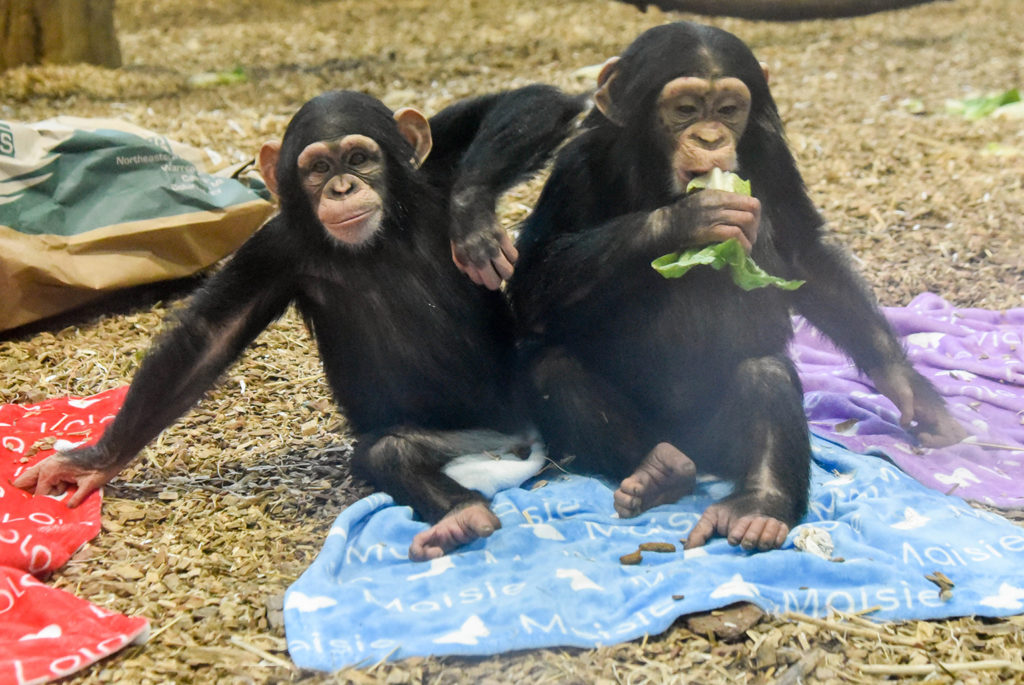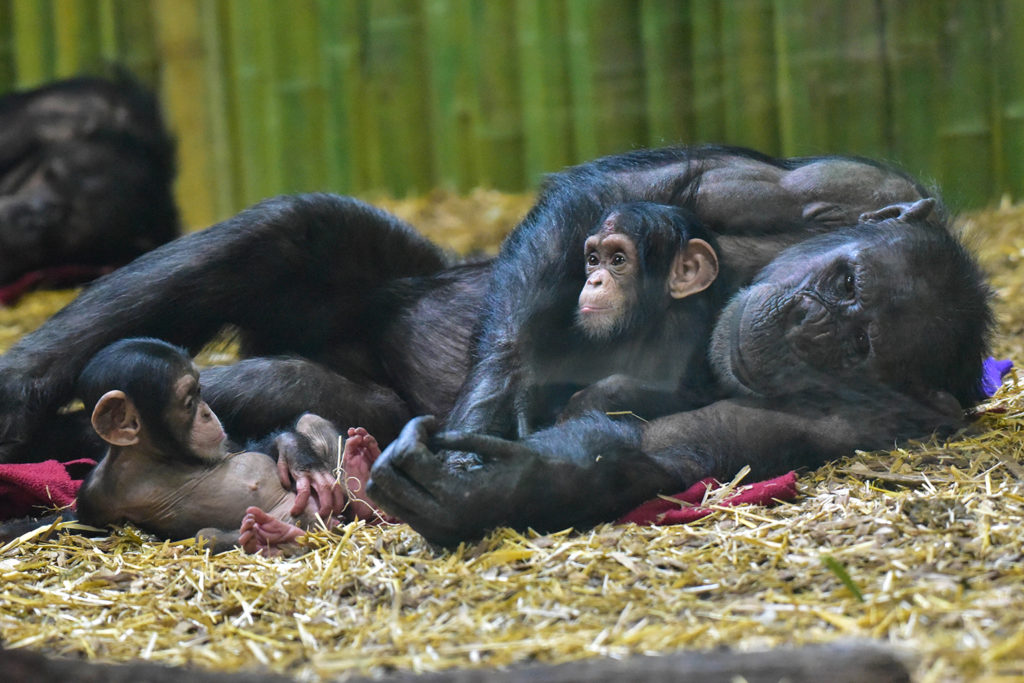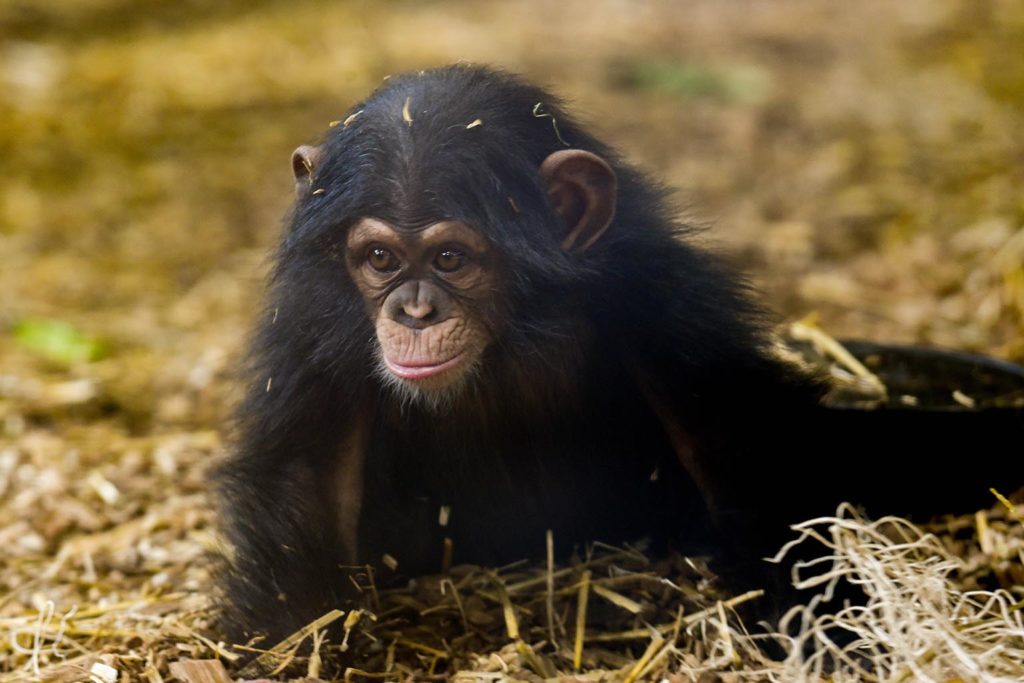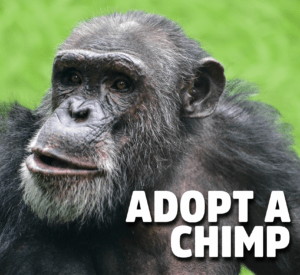Overview
“Where I live”
Chimpanzees dwell mainly in the tropical rainforest belt of central Africa but are opportunistic enough feeders to survive in other habitats as well. Less dense populations exist in other habitat types, including montane forests, seasonally dry forests, and savannah-woodlands.
“How I live there”
Chimpanzees are highly social animals that live in communities ranging up to a few hundred members. Individuals travel and feed in smaller groups within the community. Males tend to stay with the same group from birth, whereas females may move to a neighboring group when they reach adolescence. Adult chimps sometimes transfer to a new group, but not often, as they usually face aggression as newcomers.
Within every group, social status is strictly established but always changing. Males form a dominance hierarchy, with an alpha male at the top. They are in constant competition with each other for rank. Females also have their own dominance hierarchy, with an alpha female, but defer to males within the group. Males are larger and physically stronger than females, giving them the edge in dominance. Females also tend to be less sociable than males. Their bonds with other adults, whether male or female, are not as strong as those of males. Their closest bonds are with their offspring.
Chimpanzees learn from birth how to get along in a group. They watch their mothers and other members of the group and learn everything from them: how to feed, where to sleep, how to groom, how to “read” other chimps’ behaviors, and how to interact with others. Only by learning appropriate behaviors will a chimp be tolerated by other members of the group and survive. Social grooming, play, physical displays, and willingness to share food are some of the ways that chimpanzees form and maintain bonds with each other.
Chimpanzees have large brains relative to their body size. They are capable problem solvers, they understand cause and effect, and they are tool makers as well as users. They also are very adept at predicting and manipulating the behavior of others. They vocalize a great deal, keeping in touch across long distances and alerting each other to food and threats through a variety of sounds. They communicate extensively through body language as well. Just through facial expressions, chimpanzees can communicate fear, contentment, aggression, playfulness, submission, begging, excitement, and other states. Chimpanzees also have shown some capability, in captivity and with intensive training, to communicate symbolically through sign language.
Chimpanzees are diurnal, meaning that they are awake and active during the day. They spend at least half of their day feeding. While they feed mostly in trees on fruit and other plant matter, they move from place to place on the ground, walking quadripedally on their knuckles. They will cover many miles in a day in order to feed. They are primarily vegetarian but eat some meat as well. Males most often hunt cooperatively in groups, preying upon some fellow primates and other small to medium-sized mammals.
Males tend to move about more freely than females, using their community’s entire range. Females with offspring are more likely to stay put within a prescribed area. Females in estrus may range widely, usually accompanied by many males. Sometimes females in estrus venture into another community’s territory. Other chimps don’t do this because it can be dangerous business. Wandering chimps that enter another community’s territory are often violently attacked. Relations between communities are often antagonistic.
“Making my mark”
The most important way for any chimpanzee to make its mark, as already described, is within its group. Finding one’s place in the group is the first key to survival for a chimp, and the importance of following the rules of social etiquette can’t be underestimated. The status of an individual chimpanzee is often directly related to the hierarchical rank of its mother.
“What eats me”
Humans are the main predator that chimpanzees face. They have very few other predators.
Raising Young
Female chimpanzees usually give birth to their first offspring in their early teens. When a female is in estrus, she will mate with many males in the community, although higher-ranking males may try to protect her and fend off other suitors. After a 7.5 month pregnancy, she will give birth usually to one offspring and rarely to twins. She will give birth only once every five years, on average. For at least four years, she will nurse and care for her offspring before cycling into estrus again. For the first several months of life, a baby chimpanzee is pressed constantly to its mother’s body. It will cling to her and she will carry it around, never putting it down. Gradually, a mother will allow her offspring to venture away from her for longer periods of time, and will let other trusted females — very often siblings — carry her offspring. The mother is ever watchful and will rush to her offspring at any sign of threat or trouble. The mother will spend a great deal of time grooming her baby and vocalizing soothingly, to calm and reassure but also to teach this important social behavior. Even after weaning, a mother will maintain strong bonds with her older offspring.
Males reach full adult size at about age 16. They might become fertile sooner than this, but probably won’t mate often until they reach full size and can compete successfully with other males for access to females.
Conservation
Chimpanzees are an endangered species. Only about 150,000 chimpanzees survive in African forests today, down from one to two million in 1900. They are endangered for many reasons, including poaching, habitat loss, and disease introduced by humans. Much of their habitat has been lost to deforestation in response to logging, creation of farmland, and other human encroachment. Probably the greatest threat to chimpanzees today, though, is overhunting.
READ MORE:
Chimpanzees are one of the species most severely imperiled by the commercial bushmeat trade. In Africa, forest is called “bush.” The flesh of wild animals taken from forest is called “bushmeat.” The sale of bushmeat for profit, now occurring on an international scale, poses the most significant immediate threat to wildlife in Africa and around the world.
What was once limited to subsistence hunting by local people has escalated to large-scale commercial hunting in African forests. This surge in commercial hunting has followed a rise in industrial activity in “the bush.” Logging and mining companies have cut roads deep into the forests, making it easier for commercial hunters to get in, camp, hunt, get out, and take bushmeat to market.
Bushmeat is sold not only in local African villages but internationally, including here in the United States. Many consumers consider it a delicacy. So long as there is demand for bushmeat — and without practical economic alternatives — hunters will supply it.
The bushmeat crisis is real and entrenched and threatens to wipe out many forest species, including chimpanzees and most other African primates, within decades. It is a crisis that won’t be solved simply, but can be solved – through increased consumer awareness, through ongoing dialogue at all levels, and ultimately through adequate incentives to local people to conserve rather than poach wild animals. One of the most important things to realize about the bushmeat crisis is that it is not solely an African problem; it is a global problem that requires global action.
There is no doubt that chimpanzees face a precarious future. The impacts of habitat loss and hunting are particularly devastating to them because, as with many large mammals, they reproduce slowly. This makes it challenging for populations to rebuild. There is still great hope for chimpanzees, though. Numerous organizations and thousands of individuals around the world are working to protect African forests, find viable solutions to the bushmeat crisis, and save this species — so closely related to us — from extinction.
Taxonomy
- Kingdom: Animalia
- Phylum: Chordata
- Subphylum: Vertebrata
- Class: Mammalia
- Order: Primates
- Family: Hominidae
- Genera: Pan
- Species: troglodytes





